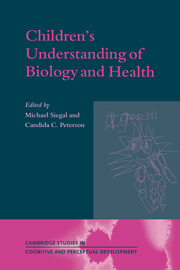Book contents
- Frontmatter
- Contents
- List of contributors
- Preface
- 1 Becoming mindful of biology and health: an introduction
- Part I Development of biological understanding
- 2 Children's understanding of mind–body relationships
- 3 How a naive theory of biology is acquired
- 4 Constructing a coherent theory: children's biological understanding of life and death
- Part II Health issues
- Part III Applications
- Appendix: Hypothetical dilemma vignettes
- Author index
- Subject index
2 - Children's understanding of mind–body relationships
Published online by Cambridge University Press: 06 July 2010
- Frontmatter
- Contents
- List of contributors
- Preface
- 1 Becoming mindful of biology and health: an introduction
- Part I Development of biological understanding
- 2 Children's understanding of mind–body relationships
- 3 How a naive theory of biology is acquired
- 4 Constructing a coherent theory: children's biological understanding of life and death
- Part II Health issues
- Part III Applications
- Appendix: Hypothetical dilemma vignettes
- Author index
- Subject index
Summary
Until the mid-1980s, it had been believed that young children do not understand the mind–body distinction; they tend to interpret and explain bodily phenomena or processes within a working framework of the mind, i.e., in terms of intentional causality (Carey, 1985). For example, when asked why children grow bigger, preschool children often say, “Because they want to grow bigger.” Even when children know that an input (e.g., eating a lot) is related to an output (e.g., becoming fatter), they know nothing about what mediates the process at a physiological level. They either give no explanation or offer an intentional explanation.
However, an increasing number of studies conducted since the late 1980s have revealed that young children have reasonable, if not accurate, understanding of bodily phenomena. That is, they can distinguish somatic phenomena or processes from mental ones, though the characterization of their understanding is still a subject of debate. Needless to say, such understanding does not mean that children regard the mind and the body as two totally separate entities. We believe that children and lay adults do distinguish between the mind and body but recognize their interdependence, as exemplified by their acknowledgement of psychosomatic diseases. The issue of the mind–body distinction, especially in relation to illness causality, is more complex than is assumed by western modern science, in which the workings of the mind are explained by psychology, and bodily processes are explicated in terms of physiological mechanisms.
- Type
- Chapter
- Information
- Children's Understanding of Biology and Health , pp. 23 - 44Publisher: Cambridge University PressPrint publication year: 1999
- 8
- Cited by



